This article has multiple issues. Please help improve it or discuss these issues on the talk page . (Learn how and when to remove these template messages)
|
Villa Pitiana is a historic estate in the province of Florence in Italy.
This article has multiple issues. Please help improve it or discuss these issues on the talk page . (Learn how and when to remove these template messages)
|
Villa Pitiana is a historic estate in the province of Florence in Italy.
Villa Pitiana is situated at 430 Meters above sea level and its structure divides the last olive groves of Valdarno from the centuries-old trees of the Vallombrosa. On 3 July 1039 the Abbess Itta of the convent of Saint Ellero donated the land in Vallombrosa to S. Giovanni Gualberto but to maintain them had to add a farm with a vegetable garden and vines in Pitiana. [1] Halfway through the 13th century Pitiana's strategic position made it a bone of contention in the florentine Guelp-Ghibelline struggles. The oldest part of the villa datating back to the 14th century is a "casa da signore", a fortified building with a high tower, used as refuge by villagers in times of war.
In the summer of 1483 Lorenzo il Magnifico de Medici tried to purchase the villa from military don Biagio Milanesi however it remained under military control due to its strategic location. From the 15th to the 17th centuries, Tuscan agriculture underwent one of its most difficult periods. Political power was now under the control of merchants and bankers and commercial activity was subsidised to the detriment of farming.
Pitiana underwent a vast restoration in the Renaissance period: in 1610, as shown by a large engraving at the entrance of the castle, the rear wing was added with its three floor façade. From the same period is the late-Mannerist coat-of-arms with the staff of S. Giovanni Gualberto and the mitre, the symbol of the bishopric dignity of the abbot of Vallombroda, in the larger courtyard of Pitiana.
In 1808 when Tuscany was annexed to Napoleon's empire the Abbey of Vallombrosa was suppressed and all its possessions including Pitiana were alienated to private owners to replenish the state coffers- except the forest which remained state owned. The Church however managed to regain ownership of Pitiana for a brief period. Eventually, Villa Pitiana passed into the possession of the Grottanelli family. At the end of the 19th century the Pitiana farm was transformed into a villa, yet maintaining farming activities in some parts of the estate.
Pitiana facade is a neo-Renaissance architecture as part of Giuseppe Poggi's work in Florence during the late 19th century, with major renovation work undergone between 1897 and 1931.
Villa Pitiana was privatised by the estate into a modern day hotel. [2]
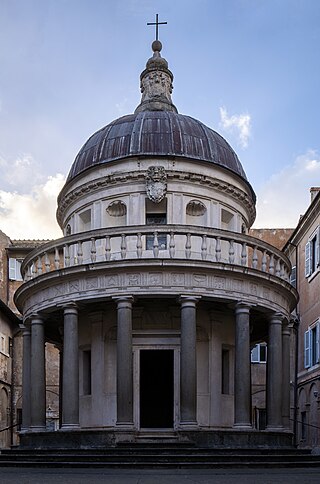
Renaissance architecture is the European architecture of the period between the early 15th and early 16th centuries in different regions, demonstrating a conscious revival and development of certain elements of ancient Greek and Roman thought and material culture. Stylistically, Renaissance architecture followed Gothic architecture and was succeeded by Baroque architecture and neoclassical architecture. Developed first in Florence, with Filippo Brunelleschi as one of its innovators, the Renaissance style quickly spread to other Italian cities. The style was carried to other parts of Europe at different dates and with varying degrees of impact.

Livorno is a port city on the Ligurian Sea on the western coast of the Tuscany region, Italy. It is the capital of the Province of Livorno, having a population of 158,493 residents in December 2017. It is traditionally known in English as Leghorn.
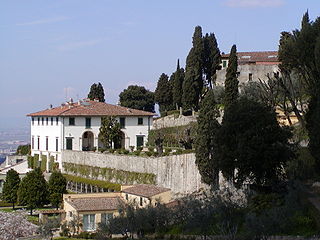
A villa is a type of house that was originally an ancient Roman upper class country house. Since its origins in the Roman villa, the idea and function of a villa have evolved considerably. After the fall of the Roman Republic, villas became small farming compounds, which were increasingly fortified in Late Antiquity, sometimes transferred to the Church for reuse as a monastery. Then they gradually re-evolved through the Middle Ages into elegant upper-class country homes. In the early modern period, any comfortable detached house with a garden near a city or town was likely to be described as a villa; most survivals have now been engulfed by suburbia. In modern parlance, "villa" can refer to various types and sizes of residences, ranging from the suburban semi-detached double villa to, in some countries, especially around the Mediterranean, residences of above average size in the countryside.

The Villa Farnese, also known as Villa Caprarola, is a pentagonal mansion in the town of Caprarola in the province of Viterbo, Northern Lazio, Italy, approximately 50 kilometres (31 mi) north-west of Rome, originally commissioned and owned by the House of Farnese. A property of the Republic of Italy, Villa Farnese is run by the Polo Museale del Lazio. This villa is not to be confused with two similarly-named properties of the family, the Palazzo Farnese and the Villa Farnesina, both in Rome.

Giuliano da Sangallo was an Italian sculptor, architect and military engineer active during the Italian Renaissance. He is known primarily for being the favored architect of Lorenzo de' Medici, his patron. In this role, Giuliano designed a villa for Lorenzo as well as a monastery for Augustinians and a church where a miracle was said to have taken place. Additionally, Giuliano was commissioned to build multiple structures for Pope Julius II and Pope Leo X. Leon Battista Alberti and Filippo Brunelleschi heavily influenced Sangallo and in turn, he influenced other important Renaissance figures such as Raphael, Leonardo da Vinci, his brother Antonio da Sangallo the Elder, and his sons, Antonio da Sangallo the Younger and Francesco da Sangallo.

Villa del Poggio Imperiale is a predominantly neoclassical former grand ducal villa in Arcetri, just to the south of Florence in Tuscany, Central Italy. Beginning as a villa of the Baroncelli of Florence, it was seized by the Medici, became the home of a Medici princess, and a lavish retreat for a Grand Duchess with imperial pretensions. Later given to Napoleon's sister, it was reclaimed by the hereditary rulers of Tuscany before being finally converted to a prestigious girls' school. During its long history, it has often been at the centre of Italy's turbulent history, and has been rebuilt and redesigned many times.

Vallombrosa is a Benedictine abbey in the comune of Reggello, about 30 km south-east of Florence, in the Apennines, surrounded by forests of beech and firs. It was founded by Florentine nobleman Giovanni Gualberto in 1038 and became the mother house of the Vallumbrosan Order.

Greve in Chianti is a town and comune (municipality) in the Metropolitan City of Florence, Tuscany, Italy. It is located about 31 kilometres (19 mi) south of Florence and 42 kilometres (26 mi) north of Siena.

Giovanni Gualberto was an Italian Roman Catholic abbot and the founder of the Vallumbrosan Order. Born into a noble family, Gualberto was a predictably vain individual who sought pleasure in vanities and romantic intrigues. When his older brother Ugo was murdered, Gualberto set out for revenge. He found the murderer in Florence, but as it was Good Friday, granted the killer's plea for mercy. Soon after Gualberto became a member of the Order of Saint Benedict though he left in order to found his own congregation. He condemned nepotism and all simoniacal actions and was known for the pureness and meekness of his faith. Even popes held him in high esteem.

Lorenzo di Niccolò or Lorenzo di Niccolò di Martino was an Italian painter who was active in Florence from 1391 to 1412. This early Renaissance artist worked in the Trecento style, and his work maintains influences of the Gothic style, marking a transitional period between the Gothic sensibilities of the Middle Ages while simultaneously beginning to draw on the Classical. Lorenzo's works were usually religious scenes in tempera with gold backgrounds.

Antonio Franchi (1638–1709) was an Italian painter of the 17th century, active mainly in Florence and Lucca.
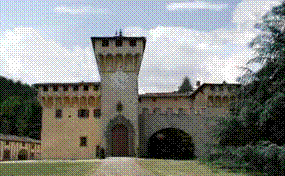
The Villa Medicea di Cafaggiolo is a villa situated near the Tuscan town of Barberino di Mugello in the valley of the River Sieve, some 25 kilometres north of Florence, central Italy. It was one of the oldest and most favoured of the Medici family estates, having been in the possession of the family since the 14th century, when it was owned by Averardo de' Medici. Averardo's son, Giovanni di Bicci de' Medici, is considered to be the founder of the Medici dynasty.
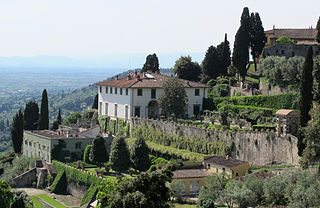
The Medici villas are a series of rural building complexes in Tuscany which were owned by members of the Medici family between the 15th century and the 17th century. The villas served several functions: they were the country palaces of the Medici, scattered over the territory that they ruled, demonstrating their power and wealth. They were also recreational resorts for the leisure and pleasure of their owners; and, more prosaically, they were the centre of agricultural activities on the surrounding estates. In 2013, the Medici villas were added to UNESCO's World Heritage list.

Villa Caldogno is a villa in the Veneto region of Italy, which is attributed to Italian Renaissance architect Andrea Palladio. It was built for the aristocratic Caldogno family on their estate in the village of Caldogno near Vicenza. It is also known as the "Villa Nordera" after Dr. Ettore Nordera who owned the property through a large part of the 20th century.
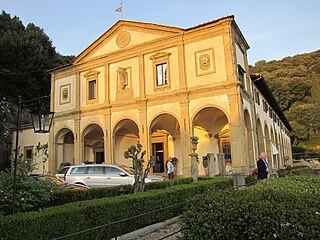
The Belmond Villa San Michele is a hotel situated on the hill of Fiesole overlooking Florence, Italy. It is named after the church of St Michael the Archangel. Today it is owned by Belmond Ltd. and is operated as a luxury hotel.

Villa il Gioiello is a villa in Florence, central Italy, famous for being one of the residences of Galileo Galilei, which he lived in from 1631 until his death in 1642. It is also known as Villa Galileo.

The Torre del Gallo is a historical building located in Florence, Italy, located at Pian de' Giullari, in the hills of Arcetri, on top of a ridge overlooking the city where there is a magnificent panorama.
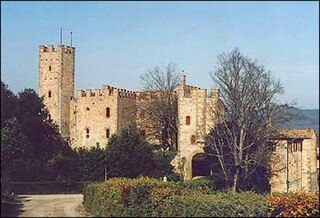
The castle of Montalto lies east of Siena, Italy, in an area known as ‘la Berardenga’, which is an extensive territory in the Chianti region of Tuscany. Its position right on the border between the territories of Siena and Florence gave it great strategic importance during the 13th, 14th and 15th centuries. Much of the castle is from medieval times and parts date back to 1000 or earlier; extensive restorations were performed in the 16th century and again in the 19th century.

Siena is a city in Tuscany, Italy. It is the capital of the province of Siena. Siena is the 12th largest city in the region by number of inhabitants, with a population of 53,062 as of 2022.
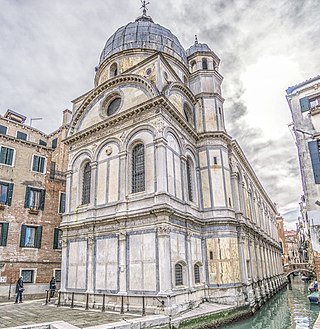
Venetian Renaissance architecture began rather later than in Florence, not really before the 1480s, and throughout the period mostly relied on architects imported from elsewhere in Italy. The city was very rich during the period, and prone to fires, so there was a large amount of building going on most of the time, and at least the facades of Venetian buildings were often particularly luxuriantly ornamented.